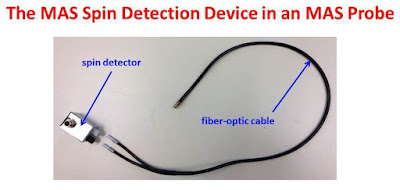Testing an MAS Spin Detection Device
Recently, I had a problem with an
MAS probe which would no longer allow measurement of an MAS spinning frequency. I thought it might be instructive to describe the device and the steps I took to solve the problem. An MAS spin detection device includes an IR LED source, an IR detector, a fiber-optic cable (split in two on one end), some electronics and an MAS speed controller. Everything except the the MAS speed controller is shown in the figure below.

The spin detector is connected through a three-pin cable to the MAS speed controller from which it receives power and to which it sends information about the MAS rotor frequency. The IR LED emitter inside the spin detector sends IR light through one leg of the split end of the fiber-optic cable. The IR light passes through the fiber-optic cable where it is directed towards the bottom of the MAS rotor. The position of the end of the fifer-optic cable with respect to the bottom of the rotor is very critical. The IR light must strike the bottom to the rotor. Half of the rotor bottom is marked with a black pen. When the IR light strikes the dark side of the rotor, there is very little reflected IR light "seen" at the end of the fiber-optic cable near the rotor. When the IR light strikes the white side of the rotor, most of the IR light is reflected back to the end of the fiber-optic cable and returned to the detector through one of the spit ends. When the rotor is spinning an "off" - "on" binary pulse equal to the rotor spinning frequency is returned to the detector and sent to the MAS speed controller through the electronic cable. If the device does not work, one possible problem could be that the fiber-optic cable is broken. This can happen if the cable is fastened too tightly to a support rod in the probe. It can be tested as shown in the figure below with a laser pointer or a flashlight.

Almost all of the light should pass through the fiber-optic cable. Another possible problem could be a failing IR LED emitter. Unfortunately, the IR light is not visible so you cannot just inspect it visually. The IR light can however be detected by the front facing camera of an iPhone which does not have a built-in IR filter like the rear-facing camera. Simply taking a picture with the front facing camera will indicate whether the emitter is working. This is shown in the figure below, where the emitter is clearly visible when the spin detector receives power from the MAS speed controller but not visible when not connected to the MAS speed controller.
There could also be a problem with the detector. This can be tested with a stroboscopic LED flashlight as shown in the figure below.
The strobe light is positioned at the end of the fiber-optic cable and one of the split ends is positioned at the detector. When the spin detector is connected to the MAS speed controller, one should be able to observe the frequency of the strobe light on the rotor frequency display. Other possible problems could be with the MAS speed controller or with the electronic cable. I have two MAS probes for this instrument. In one probe, the MAS spinning frequency could not be counted and in the other probe it could. In the failing probe, the fiber-optic cable, IR LED emitter and IR detector were all working properly. The problem was with the connector on the cable between the spin detector and the MAS speed controller. The connection was OK for one probe but not the other. I will be happy if this post helps someone who may run into a similar problem.


Source:
University of Ottawa NMR Facility Blog



